
|
|
Shodai / 1st. GENERATION, HIZEN MASAHIRO"
C - 1624 SWORD MAKER TO THE "NABESHIMA DAIMYO"
NBTHK Tokubetsu Hozon
Rated "upper class" (Jo - Saku)
Tanobe Michihiro sensei sayagaki pending


Fittings: Mino Goto school with flowers and praying mantis
Saya: with Gold-speckled nashiji lacquer and diverse mother-in-pearl accents

This blade was produced in
Hizen province, by 1st. Generation Masahiro, c - 1624 AD. (average working
date). He was a contemporary of Hizen Tadahiro, and one of the finest makers of
the Tadayoshi school, both he and Tadahiro were sword makers to the famous
"NABESHIMA DAIMYO FAMILY". He is rated "upper class" (Jo - Saku). The first
name he used as a sword smith was Masanaga, his given name was Sadenjiro, he
received this from his father Yoshinobu. His rather short, but prolific
career ended in Kan-bun the 5th. Year, or 1665 ad., at the age of "59" years. Nidai Masahiro, the son of Shodai Masahiro,
was born in 1627 and also began his career using the mei Masanaga. The two
Masahiro smiths are known best for their use of midare-ba.
Nagasa- 70.0 cm ~ 27 7/8
Sori- 1.3 cm ~ 1/2"
Motohaba (width)- 3.15 cm ~ 1 1/4"
Nakago- UBU (unaltered)
Koshirae- Kin madara-nashiji-nuri aogai-raden saya uchigatana-koshirae
(金斑梨地塗青貝螺鈿鞘打刀拵) – Uchigatana-koshirae with saya in
gold-speckled nashiji lacquer and diverse mother-in-pearl accents. "mounted on tsunagi"
Fittings- Mino Goto school
Fuchi mei- Ichiryū Dairi + kaō (一柳・大里「花押」)
Mounting- Hilt covered in white same and wrapped jabaramaki style with brown cord. Fuchigashira of shakudō with nanako ground and iroe accents, depicting autumnal vegetation and insects. Menuki of shakudō and in katachibori with iroe accents, depicting autumnal vegetation and insects. Tsuba of angular shape with rounded corners, one hitsu-ana, of shakudō and with takabori relief and iroe accents, depicting autumnal vegetation and insects.
Habaki- Kinkise koshi Yūjō, A gold foil habaki with design originally made by Yūjō
Certificates- blade- NBTHK Tokubetsu Hozon, koshirae- NTHK-NPO
Sayagaki- This Masahiro is in Japan now to receive Tanobe Michihiro (TANZAN) sensei sayagaki as of 8/2022.
Reference information from - Index of Japanese sword smiths By Markus Sesko Available for purchase - click here.
"Masahiro (正広), 1st gen., Kan´ei (寛永, 1624-1644), Hizen – „Hizen no Kuni Saga-jū Masahiro“ (肥前国佐賀住正広), „Kawachi no Daijō Fujiwara Masahiro“ (河内大掾藤原正広), „Hizen no Kuni Saga-jū Kawachi no Daijō Fujiwara Masahiro Hashimoto Sadenjirō Masanaga“ (肥前国佐賀住河内大掾藤原正広橋本左伝次郎正永), „Hizen no Kuni Saga-jū Kawachi no Daijō Fujiwara Masahiro saku“ (肥前国佐賀住河内大掾藤原正広作), civilian name „Hashimoto Sadenjirō Masanaga“ (橋本左伝次郎正永), he changed his first name later to „Yashichibei“ (弥七兵衛), he was born in the twelfth year of Keichō (慶長, 1607) as oldest son of Yoshinobu (吉信), when his grandfather Tadayoshi (忠吉) changed his name to „Tadahiro“ (忠広) he succeeded him as „Tadayoshi“ but on orders of his lord Nabeshima Katsushige (鍋島勝茂, 1580-1657) he changed his name on the 19th day of the eleventh month Kan´ei wo (1625) to „Masahiro“ (正広), that means only about one year after he started to use the name „Tadayoshi“, genealogic records of the Masahiro line mention that he received the honorary title „Kawachi no Daijō“ on the 27th day of the fourth month Kan´ei five (1628) but he did not sign with this title until Kan´ei 16 (1639), therefore there exists the theory that he received the title not before the end of the Kan´ei era, Masahiro enjoyed a special patronage of Nabeshima Katsushige and it is said that he had a certain „exclusive contract“ with him and that he was not allowed to work for other customers, this would also explain why he did not use his honorary title or dated his blades, and this on the other hand could support the old handed-down information that he received the tite „Kawachi no Daijō“ actually in Kan´ei five but just did not use it, it is also recorded that he took care of the 2nd gen. Tadahiro (忠広) after the death of the 1st gen. Tadayoshi, he died on the fifth day of the second month Kanbun five (寛文, 1665) at the age of 59, dense ko-mokume with fine ji-nie which appears as konuka-hada, the hamon is a bright gunome-midare, me mixed with chōji and/or ashi and yō in ko-nie-deki with broad nioiguchi, the yakigashira are roundish and there are nie and sunagashi seen in the valleys of the midare elements, but he also applied a suguha or a gunome with regular interval between the individual gunome elements, wazamono."
The
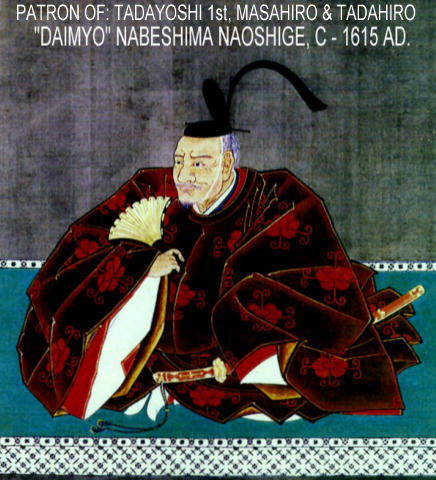
In the late 16th century, the feudal lord Nabeshima Naoshige would write a set of wall inscriptions for his followers. Historians describe the wall inscriptions as "Everyday wisdom, rather than house laws proper" Lord Nabeshima's written works also include a mention of bushido:
- "Bushido is in being crazy to die. Fifty or more could not kill one such a man"
In 1584, Nabeshima Naoshige was the chief retainer for the Lord of Hizen until he was killed in battle by the forces of the powerful Shimazu Clan. After his lord's death, Nabeshima became the true leader of the fiefdom and fought against the Shimazu again in 1587. A Sengoku era warlord, Nabeshima distinguished himself in battle by killing hundreds of men. He was later sent on Hideyoshi's Korean campaigns where he struck up a friendship with Kato Kiyomasa and upon his return to Hizen, Tokugawa Ieyasu.
At Sekigahara, Lord Nabeshima's son, Katsushige, was convinced to take sides against Tokugawa Ieyasu. Nabeshima wisely recalled him to attack Tokugawa's enemies in Kyushu, thus saving the clan from disaster. Historians describe Nabeshima as "a survivor and a man of quick intelligence" who saved his domain from invasion several times. His actions and sayings are immortalized in the third chapter of the Hagakure by writer Tsunetomo Yamamoto, a close attendant of Nabeshima Naoshige's grandson, Mitsushige.
(click for larger view)
Kantei-Sho (鑑定書) – Appraisal
No 1009821
Katana, signed: Hizen no Kuni Kawachi no Kami Fujiwara Masahiro
(肥前国河内守藤原正広) – “Kawachi no Kami Fujiwara Masahiro from Hizen province”
nagasa ~ 70.9 cm
According to the result of the shinsa committee of our society, we judge this work as authentic and rank it asTokubetsu-Hozon Tōken.
December 10, 2018
[Foundation]
Nihon Bijutsu Tōken Hozon Kyōkai, NBTHK (日本美術刀劍保存協會)
photos in this section are clickable for high resolution images
(click for larger view)
Kantei-sho (鑑定書) – Appraisal
Koshirae (拵え)
Kin madara-nashiji-nuri aogai-raden saya uchigatana-koshirae
(金斑梨地塗青貝螺鈿鞘打刀拵) – Uchigatana-koshirae with saya in
gold-speckled nashiji lacquer and diverse mother-in-pearl accents
Shōshin (正真) – Authentic
Heisei 30 nen 9 gatsu 16 nichi (平成三十年九月十六日) – September 16, 2018
Non-Profit Organization (特定非営利活動法人)
Nihon Tōken Hozon Kai (日本刀剣保存会) – NTHK
Board Chairman (理事長): Miyano Teiji (宮野貞司)
No 9337
meibun (銘文) – Signature: unsigned
tsukurikomi (造り込み) – Shape: n/a
shitaji (下地) – Foundation: n/a
zugara (図柄) – Motif: n/a
hori (彫り) – Carvings: n/a
sunpō (寸法) – Measurements: 106 cm
koshirae (拵え) – Mounting: Hilt covered in white same and wrapped jabaramaki style
with brown cord. Fuchigashira of shakudō with nanako
ground and iroe accents, depicting autumnal vegetation and
insects. Menuki of shakudō and in katachibori with iroe
accents, depicting autumnal vegetation and insects. Tsuba of
angular shape with rounded corners, one hitsu-ana, of
shakudō and with takabori relief and iroe accents, depicting
autumnal vegetation and insects.
bikō (備考) – Remarks: late Edo period
shinsa’in natsu’in (審査員捺印) – Seals of Judges: 6 seals
photos in this section are clickable for high resolution images
![]()

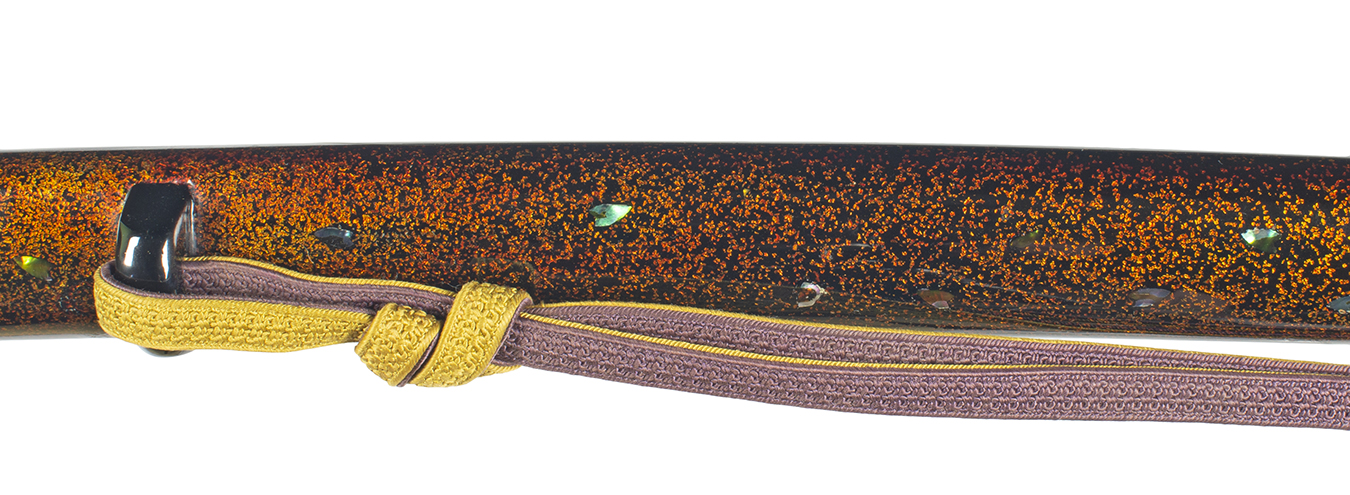
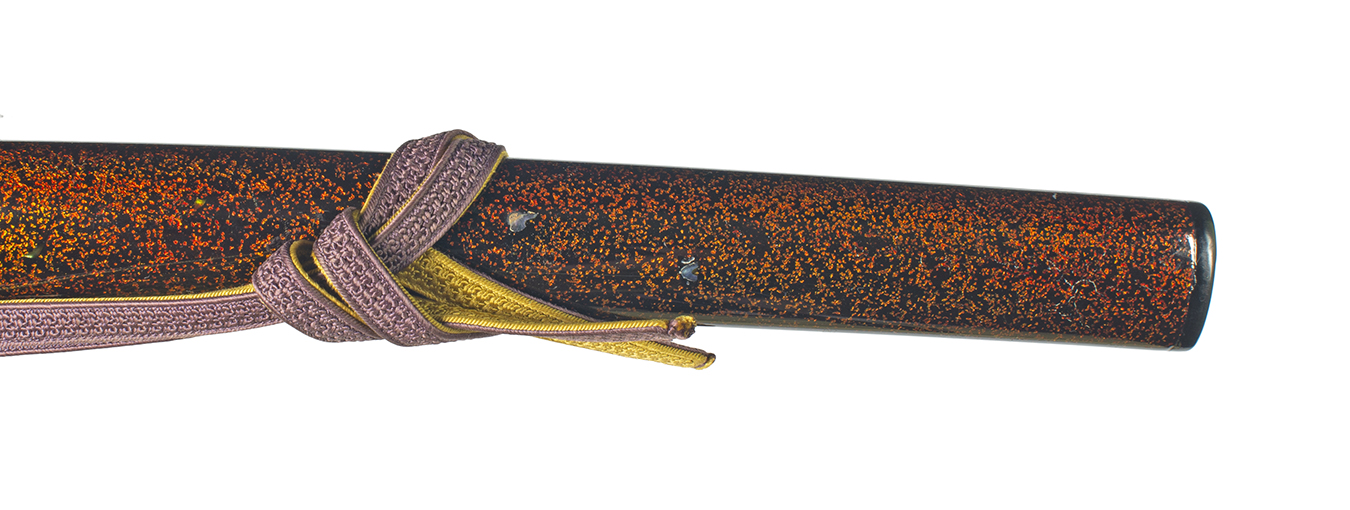
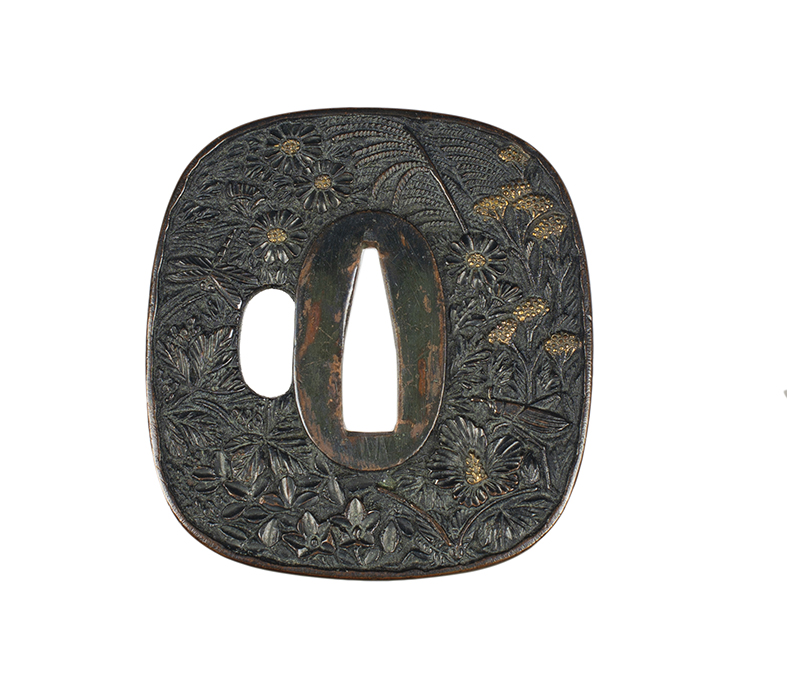
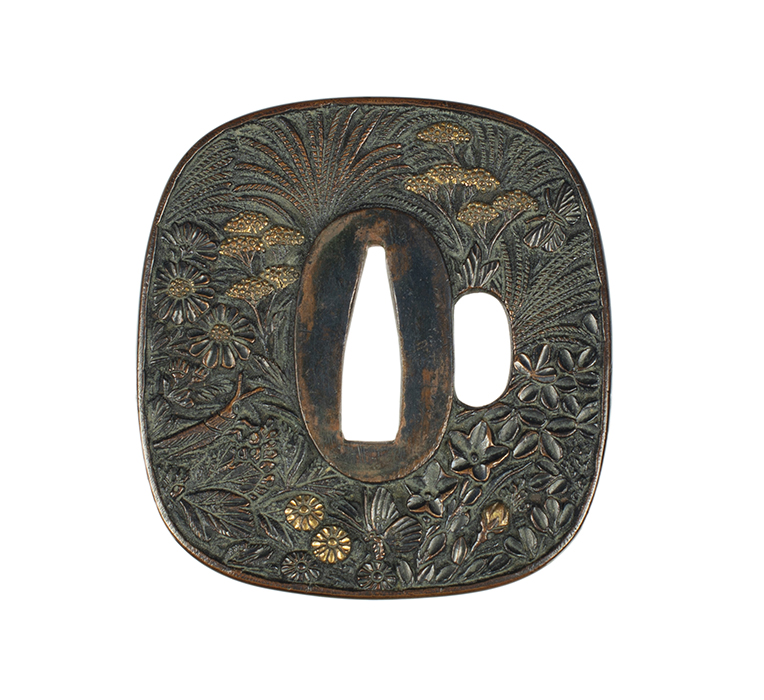
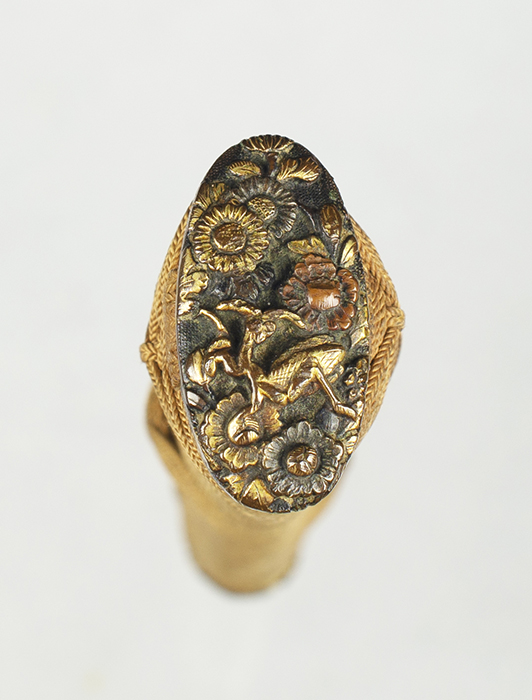
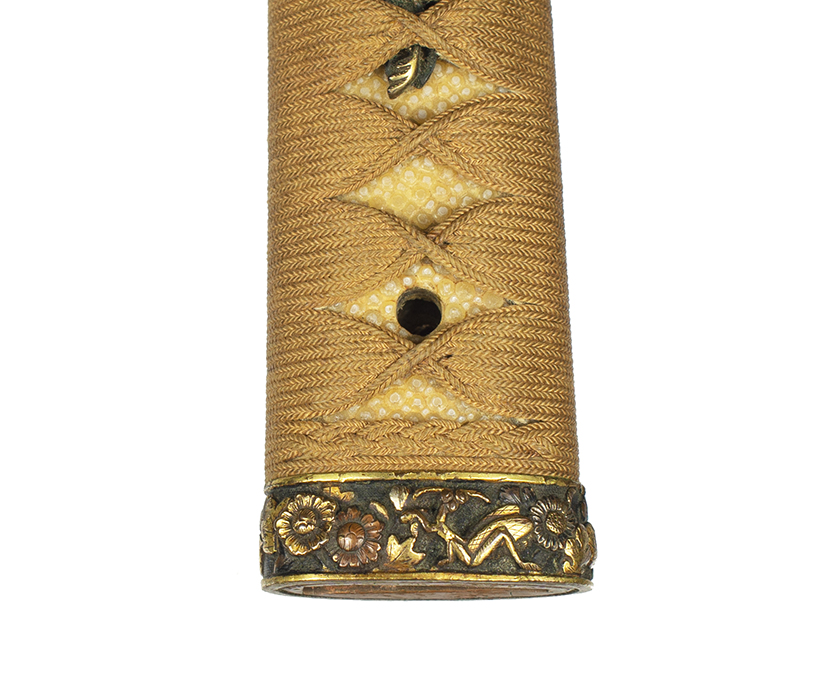
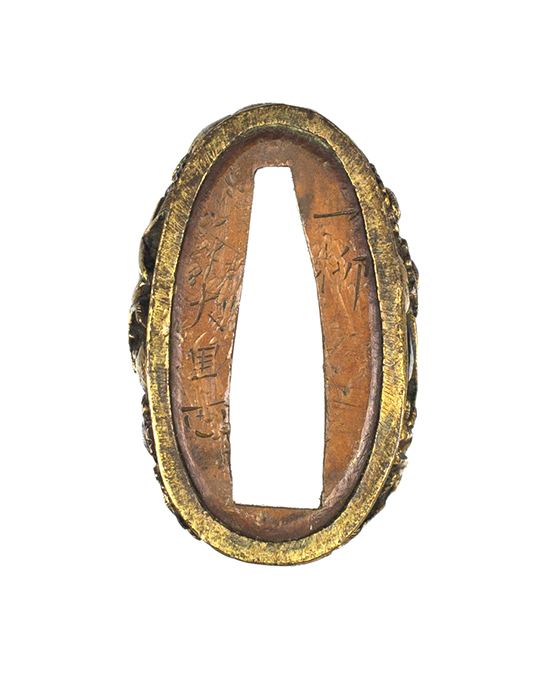
Fuchi mei- Ichiryū Dairi + kaō (一柳・大里「花押」)


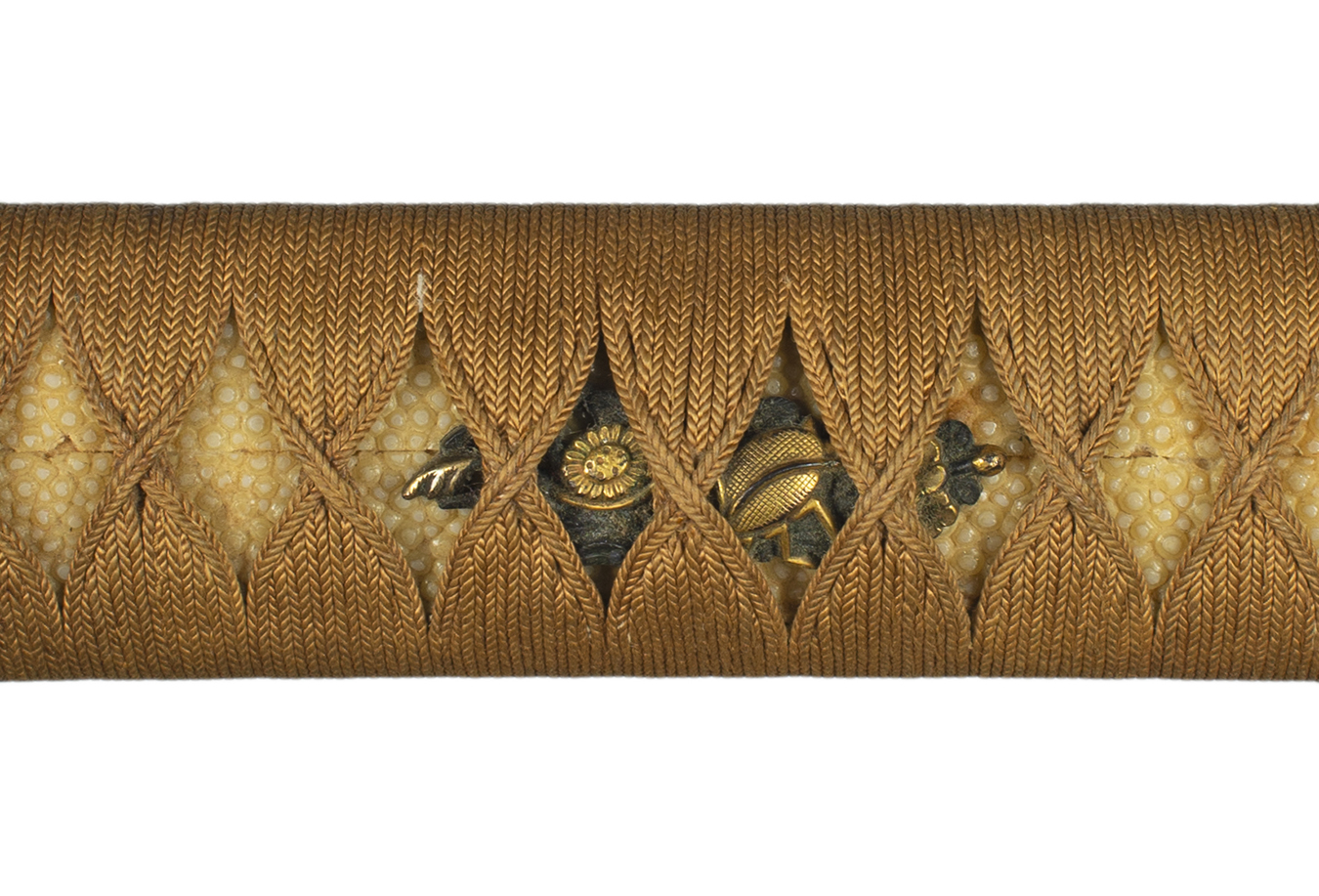
$26,000 USD
This Sword is available for purchase.
Contact via e-mail or telephone @ 1(608) 315-0083 any time
![]()
Pictures and content may not be copied without the express permission of samuraisword.com © 20
22